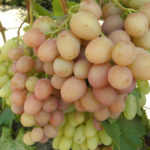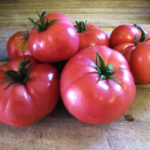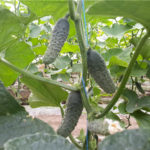Cherry variety Toy (duke)
Duke is a wonderful culture that is primarily famous for its taste. The work of breeders to instill good winter hardiness in this group of fruit trees has led to the creation of varieties that grow and bear fruit even in the northern regions. The Nurse is a good example. But in this article we will talk about a variety that is suitable for warm or temperate climates. It is called a Toy. This wonderful variety, which is a full-fledged duke, appeared in the Melitopol Institute of Irrigated Horticulture named after I. M. F Sidorenko of the Ukrainian Academy of Agrarian Sciences. The authorship belongs to the Turovtsev couple - Nikolai Ivanovich and Valentina Alekseevna, whose family and creative union gave gardeners many successful breeding achievements. Cherries were used as genetic material Lyubskaya, which served as a donor of winter hardiness, and sweet cherry Solnechny ball, the owner of excellent early maturity and high yield. According to VNIISPK, our heroine was entered into the State Register of Breeding Achievements of Russia in 1996, with an admission in the North Caucasus region. Unfortunately, today there is no registration in the State Register.
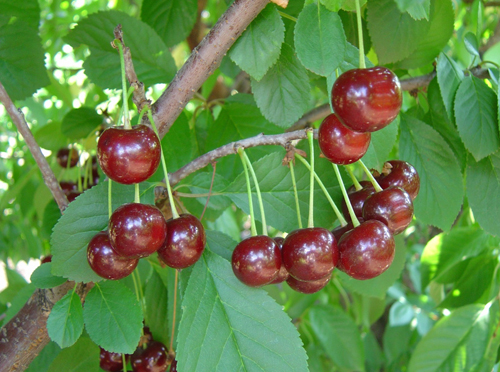
Description
The tree is powerful, tall, up to 7 meters high, which greatly complicates care and harvesting. The crown is spherical, well leafy. Cherry shoots are erect, thick, covered with smooth brown-brown bark with numerous large gray lenticels. On the trunk and branches, the bark is gray, flaky. The leaves of this variety are similar to cherry, large and wide, ovoid, with a pointed top and rounded base, dark green in color. The serrated-toothed edges of the plate are slightly raised upward, giving the leaf the shape of a boat, but at the same time the apex is bent downward. Stipules are short, strongly dissected, and fall off early. The petiole is anthocyanin-colored, short and thick. The glands are arranged in 2 - 3, they are rather large, rounded, colored. Duke inflorescence consists of 2 - 3 large white flowers, on average, there are 284 buds for every hundred fruit buds. The Toy's crop is formed on annual growth and bouquet branches.
Drupes are one-dimensional, rather large, weighing 7.0 - 9.0 grams, rounded-heart-shaped. The apex is rounded, there is a depression at the base, the fossa is shallow and narrow, the abdominal suture is small, inconspicuous. A thick, medium-long stalk can be easily separated from the branch; it is not firmly attached to the stone. The skin is thin, shiny, easily separates from the pulp. During ripeness, cherry fruits turn dark red. The pulp is dark-colored, tender and juicy. The taste is good, dessert, sweet and sour, rated by tasters at 4.5 points. The juice is colored red. The stone is round, small, easily removed. 100 grams of pulp contains: solids 17.4%, sugars 10.9%, acids 1.51%.
Variety characteristics
- If you plant grafted Toy seedlings, then the harvest will not be long in coming. Fruiting in this case will begin 3 years after planting;
- in terms of ripening, duke belongs to medium early or early, it all depends on the region of cultivation. For example, under the conditions of Melitopol, ripening occurs in the last days of June. In cooler regions, this process can take a week, or even two;
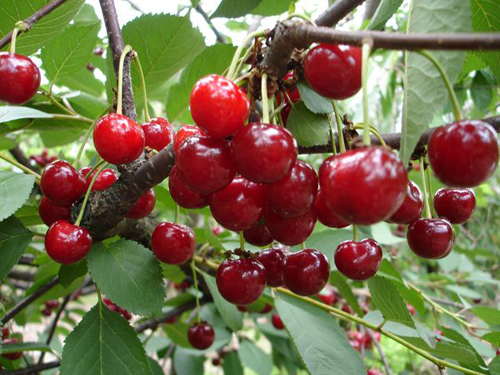
- the productivity of the variety is good. The yield increases from year to year. The ten-year-old cherry provides 45 kilograms of selected berries. In favorable years, the maximum figure was 72.1 kg per tree;
- the period of the productive life of the variety is quite long. With good care, the plant will live for about 30 years;
- winter hardiness is moderate, but quite sufficient for a warm region. Without visible damage, trees can withstand frosts down to -25.1 ° C, but the buds at this temperature can suffer - the death of flowers in cherry buds can reach 86.4%;
- VNIISPK does not mention the immunity of the variety.Considering that one of the parents of our heroine, the Sunny ball cherry, had a fairly strong immunity, then Toy could easily inherit it. As a rule, the described variety is resistant to major diseases, but in especially unfavorable years, lesions can still occur;
- drought resistance of the duke is quite high. The plant is resistant to possible dry periods, which is very welcome in the southern regions, where the weather does not indulge in precipitation in summer;
- the crop bears well the hardships of long-distance transportation. But for this you need to remove the fruit with the stalk and put it in a small layer in boxes for transportation;
- the way of use is universal. It is best to enjoy the pleasant taste of berries in their natural form. But they are also suitable for processing. From the fruits, aromatic jam, compote is obtained, cherries can be frozen with or without a stone. Or you can pamper yourself and your friends with excellent liqueur.
Pollinators
Cherry-cherry hybrid Toy is self-fertile. This fact is a full-fledged reason for planting one, or better two, reliable pollinators not far from her, which will bloom at the same time as our heroine. Of course, not everyone agrees to overload the garden with cherry crops. And here is a pleasant surprise, because not only cherries, but also cherries can be planted as a pollinator. Among the most suitable for duke pollination are cherry varieties: Minx and Samsonovka; and cherry: Large-fruited, Valery Chkalov and Franz Joseph. Thanks to this neighborhood, the fruiting of our heroine will be stable and abundant.
Agrotechnics
In warm regions, the duke is usually planted in the autumn period, 2 - 3 weeks before the onset of stable cold weather. As a rule, a humid and warm autumn helps the suction roots develop quickly and provides a calm winter for the culture. But in order not to risk it, it is best to insulate the trunk circle with a layer of mulch of 15 - 20 cm. When planting in spring, the survival rate is also high. Given the tallness of the cherry, the distance to neighbors should be at least 4 meters. Agricultural technology has some features that are due to the characteristics of the culture. So, for example, the variety reacts poorly to excessive feeding. In response to the excessive application of organic matter and mineral fertilizers, it begins to grow vigorously, as a result of which the wood simply does not have time to mature by the winter period. For this reason, when planting in fertile soil, the pit should be refilled carefully, without getting carried away with fertilizing. Watering should also be taken with caution. A young tree needs watering, but does not tolerate waterlogging. But an adult duke, with a sufficient amount of natural precipitation, can not be watered at all.
The toy is quite popular in regions with warm and temperate climates, its success is well deserved. Cherry is unpretentious in care, pleases with good yields, large-fruited and taste. Mature trees endure the winter period without additional shelter, and in the summer a powerful root system is able to independently provide the plant with moisture. Resistance to major diseases is good, but preventive treatments should not be neglected. Disadvantages include self-infertility, but this problem can be easily solved by planting suitable pollinators nearby. But what will really concern the gardener is the large size of the variety. Taking care of it - pruning and spraying, harvesting - is not very easy. Here you cannot do without additional gardening equipment (stairs) or the ability to cleverly climb trees.
